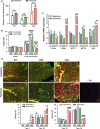PGC-1α affects aging-related changes in muscle and motor function by modulating specific exercise-mediated changes in old mice
- PMID: 29067788
- PMCID: PMC5770876
- DOI: 10.1111/acel.12697
PGC-1α affects aging-related changes in muscle and motor function by modulating specific exercise-mediated changes in old mice
Abstract
The age-related impairment in muscle function results in a drastic decline in motor coordination and mobility in elderly individuals. Regular physical activity is the only efficient intervention to prevent and treat this age-associated degeneration. However, the mechanisms that underlie the therapeutic effect of exercise in this context remain unclear. We assessed whether endurance exercise training in old age is sufficient to affect muscle and motor function. Moreover, as muscle peroxisome proliferator-activated receptor γ coactivator 1α (PGC-1α) is a key regulatory hub in endurance exercise adaptation with decreased expression in old muscle, we studied the involvement of PGC-1α in the therapeutic effect of exercise in aging. Intriguingly, PGC-1α muscle-specific knockout and overexpression, respectively, precipitated and alleviated specific aspects of aging-related deterioration of muscle function in old mice, while other muscle dysfunctions remained unchanged upon PGC-1α modulation. Surprisingly, we discovered that muscle PGC-1α was not only involved in improving muscle endurance and mitochondrial remodeling, but also phenocopied endurance exercise training in advanced age by contributing to maintaining balance and motor coordination in old animals. Our data therefore suggest that the benefits of exercise, even when performed at old age, extend beyond skeletal muscle and are at least in part mediated by PGC-1α.
Keywords: PGC-1α; aging; exercise; mitochondria; motor function; sarcopenia; skeletal muscle.
© 2017 The Authors. Aging Cell published by the Anatomical Society and John Wiley & Sons Ltd.
Figures






References
-
- Berchtold, M. W. , Brinkmeier, H. , & Muntener, M. (2000). Calcium ion in skeletal muscle: Its crucial role for muscle function, plasticity, and disease. Physiological Reviews, 80, 1215–1265. - PubMed
Publication types
MeSH terms
Substances
Grants and funding
LinkOut - more resources
Full Text Sources
Other Literature Sources
Medical
Molecular Biology Databases

